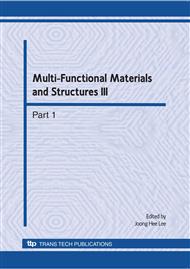p.101
p.105
p.109
p.113
p.117
p.121
p.125
p.129
p.133
High-Strength Multifunctional Conducting Polymer Hydrogels
Abstract:
A simple and versatile method has been invented to fabricate conducting polymer hydrogels via supramolecular self-assembly between polymers and multivalent cations. As-prepared hydrogels composed of poly(3,4-ethylenedioxythiophene) and poly(styrenesulfonate) (PEDOT-PSS) exhibit expanded-coil conformation in polymer chains, phase-separate at nanometer scale, possess controllable microstructure, and is responsive to external stimulus. The conducting PEDOT-PSS hydrogels have then been introduced into multiple-network hydrogels to obtain composite hydrogels combining enhanced mechanical strength and excellent electrical activity. Triple-network (TN) and special double-network (sDN) hydrogels, containing poly(acrylic acid) (PAA) and poly(acrylamide) (PAAm) as the matrix respectively, are successfully prepared. Finally, PEDOT-PSS hydrogels with self-strengthening function are directly fabricated via a one-step process under optimized conditions. The strengthening mechanisms for each kind of hydrogels are proposed, and the applicability in electrosensors, supercapacitors and electromechanical actuators are briefly demonstrated.
Info:
Periodical:
Pages:
117-120
Citation:
Online since:
August 2010
Authors:
Price:
Сopyright:
© 2010 Trans Tech Publications Ltd. All Rights Reserved
Share:
Citation:


